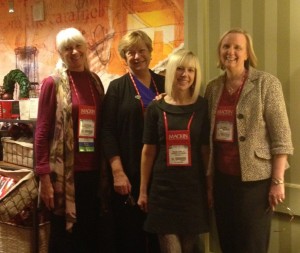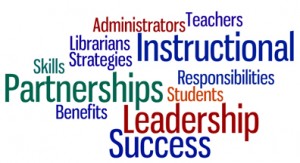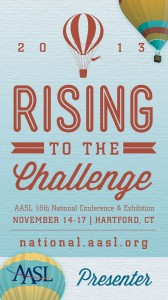 Up early to wrestle the turkey into the oven, and thought maybe a few of you might be doing the same!
Up early to wrestle the turkey into the oven, and thought maybe a few of you might be doing the same!
Traditionally on Thanksgiving, we look forward to gathering with family and friends, and we celebrate those things for which we are thankful. So this year, I have added some new reasons to be thankful, and, not surprisingly, they include recent opportunities for collaboration in my professional life.
- The collaboration blog experiment:
A little over a year ago, I was invited to have an adventure with three other library educators in launching a collaborative blog about collaboration. The brainchild of Judi Moreillon, our mission was to share research, best practices, co-teaching ideas, and our own experiences about the many facets of collaboration in today’s schools. Social media was our vehicle to reach pre-service and practicing teacher librarians everywhere to generate discussion and comment. Along with Melissa Johnston and Sue Kimmel, we met virtually through a Google Hangout and through emails to organize a framework to publish our ideas on a rotating basis. As far as Judi could determine, there was no other blog quite like this one, so it was an experiment. We are still going strong, and are learning as we go- with continual tweaking and reflection about improving content and delivery. I have thoroughly enjoyed the experience and have appreciated a venue to share my voice on the art and science of collaboration and education that really resonate with me.
One of my highlights at the recent AASL Conference in Hartford, CT was the chance to get together with my blogging partners face to face. I had met Sue at the AASL Fall Conference in 2012, but I had not met Judi or Melissa in person, only virtually. It was a treat to have a “real” conversation with others in the profession who walk the walk, and talk the talk in higher education. Each one of us has a unique lens and voice for examining aspects of collaboration that improve learning for our colleagues and our students. I so admire how they can manage the spinning plates: teach courses, conduct research, write books and articles, speak at conferences, and of course-blog! In the photo above you can see our smiles, as we enjoyed the moment-from the left, Judi, Judy, Melissa, and Sue- convening at Starbucks. Thanks to all of you, and I look forward to continuing the adventure…
- Collaboration for advocacy:
In my posts earlier this fall, I shared the story about collaborative efforts for advocacy by the Vermont School Library Association. When faced with a situation that required collective action to effect change, our membership rallied to advocate for retaining language about school library staffing and programs in Vermont State Standards for education. Currently, as the process is still unfolding, we have been successful in that effort, and expect that the end result will be increased visibility of the role of teacher librarians and commitment to school library programs in educational communities around the state. I am so thankful for the close collaboration and relationships that have been forged in our work together. Thank you Denise Wenz, President of VSLA, Heidi Huestis, Chair-Professional Concerns, Marty Reid, Vermont State Librarian, and Jill Remick, Project Director for Education Quality Standards, and many others, too numerous to mention for all your hard work.
Final thoughts:
In spite of the challenges, it’s a wonderful time to be involved in education and teaching. I’m thankful for the energy and inspiration that comes from working and collaborating with my friends in the field. Kudos to you all for making a difference- today and tomorrow. Happy Thanksgiving.
References:
Morris, Rebecca. (2003, Nov. 25). AASL wrap up. School Library Monthly. Weblog. Retrieved from: http://blog.schoollibrarymedia.com/index.php/2013/11/25/aasl-wrap-up/
Peterson, Karyn. (2013, Nov 21). Vermont school librarians fight to keep libraries in state standards. School Library Journal. Weblog. Retrieved from: http://www.slj.com/2013/11/schools/vermont-school-librarians-fight-to-keep-libraries-in-state-standards/#_
Photo: Melissa P. Johnston

 AASL Best Apps for Teaching and Learning 2013
AASL Best Apps for Teaching and Learning 2013 During the past two weeks I have attended the Virginia Association of School Librarians Conference and the AASL Bi-Annual Meeting in Hartford. In Hartford, I attended a pre-conference led by Audrey Church, Jody Howard, Judy Bivens, and Mona Kirby on
During the past two weeks I have attended the Virginia Association of School Librarians Conference and the AASL Bi-Annual Meeting in Hartford. In Hartford, I attended a pre-conference led by Audrey Church, Jody Howard, Judy Bivens, and Mona Kirby on 
